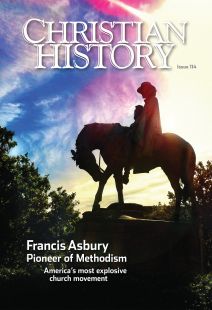The Damnation of Theron Ware
HAROLD FREDERIC was a Presbyterian journalist, but his satirical 1896 novel about a Methodist pastor who falls prey to the world, the flesh, and the devil illuminated Methodism’s changing faces. It opens in a crowded church with these words:
No such throng had ever before been seen in the building during all its eight years of existence. People were wedged together most uncomfortably upon the seats; they stood packed in the aisles and overflowed the galleries; at the back, in the shadows underneath these galleries, they formed broad, dense masses about the doors . . . [for] the closing session of the annual Nedahma Conference of the Methodist Episcopal Church, and the Bishop was about to read out the list of ministerial appointments for the coming year. . . .
There were very old men among these—bent and decrepit veterans who had known Lorenzo Dow, and had been ordained by elders who remembered Francis Asbury and even [George] Whitefield. They sat now in front places, leaning forward with trembling and misshapen hands behind their hairy ears, waiting to hear their names read out on the [retired] list. . . .
The sight of these venerable Fathers in Israel [godly older men] was good to the eyes, conjuring up, as it did, pictures of a time when a plain and homely people had been served by a fervent and devoted clergy—by preachers who lacked in learning and polish, no doubt, but who gave their lives without dream of earthly reward to poverty and to the danger and wearing toil of itinerant missions through the rude frontier settlements . . . log-huts, rough household implements, coarse clothes, and patched old saddles which told of weary years of journeying; but to even the least sympathetic vision there shone upon them the glorified light of the Cross and Crown. . . .
The large majority of those surrounding these patriarchs were middle-aged men, generally of a robust type, with burly shoulders, and bushing beards framing shaven upper lips, and who looked for the most part like honest and prosperous farmers attired in their Sunday clothes. . . . There were scattered stray specimens of a more urban class, worthies with neatly trimmed whiskers, white neckcloths, and even indications of hair-oil—all eloquent of citified charges; and now and again the eye singled out a striking and scholarly face, at once strong and simple, and instinctively referred it to the faculty of one of the several theological seminaries belonging to the Conference.
The effect of these faces as a whole was toward goodness, candor, and imperturbable self-complacency . . . it wore its pleasantest aspect on the countenances of the older men. The impress of zeal and moral worth seemed to diminish by regular gradations as one passed to younger faces; and among the very beginners, who had been ordained only within the past day or two, this decline was peculiarly marked. . . .
But nothing was further from the minds of the members of the First M. E. Church of Tecumseh than the suggestion that they were not an improvement on those who had gone before them. They were undoubtedly the smartest and most important congregation within the limits of the Nedahma Conference, and this new church edifice of theirs represented . . . a scale of outlay and a standard of progressive taste in devotional architecture unique in the Methodism of that whole section of the State. —From Chapter 1.
By Harold Frederic
[Christian History originally published this article in Christian History Issue #114 in 2015]
Harold Frederic was a Presbyterian journalist and novelist.Next articles
Doing “more beyond”
Jennie Fowler Willing, like many nineteenth-century Methodist women, set out to change the church and the world
Priscilla Pope-LevisonPreachers, fighters, and crusaders
Here are the stories of some other Methodists who helped settle—and then transform—a continent
Gary Panetta and Kenneth Cain KinghornThe patriarch broods over his family’s future
Asbury warned Methodists against settling down like other churches
Francis AsburyThe continent was their parish
Christian History talked with historian Russell Richey about who Methodists have been and how Asbury made them that way
Russell RicheySupport us
Christian History Institute (CHI) is a non-profit Pennsylvania corporation founded in 1982. Your donations support the continuation of this ministry
Donate



